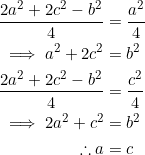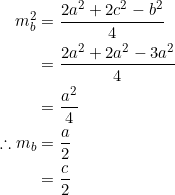Among all triangles, the only triangle whose nine-point center coincides with one of its vertices is the ![]() -triangle.
-triangle.
As such, it has unique properties, some of which will be shown in today’s post.
Additionally, the ![]() -triangle is also unique among all isosceles triangles, and we’ll see that later.
-triangle is also unique among all isosceles triangles, and we’ll see that later.
Let ![]() be the circumradius and let
be the circumradius and let ![]() be the side-lengths of a given triangle
be the side-lengths of a given triangle ![]() . By the extended law of sines we have:
. By the extended law of sines we have:
![]()
In the event that ![]() , we get
, we get ![]() .
.
Suppose that vertex ![]() of triangle
of triangle ![]() is equidistant from the midpoints of sides
is equidistant from the midpoints of sides ![]() . In particular, this means that the median from vertex
. In particular, this means that the median from vertex ![]() is equal to half the side-lengths of
is equal to half the side-lengths of ![]() and
and ![]() .
.

By the cosine formula:
![]()
Consequently, ![]() .
.
Note that the side-lengths ![]() are in the ratio
are in the ratio ![]() , and so
, and so ![]() . Consider the length of the median from vertex
. Consider the length of the median from vertex ![]() :
:

And so vertex ![]() is equidistant from the midpoints of all three sides.
is equidistant from the midpoints of all three sides.
Let the feet of the altitudes be ![]() , and let the altitudes themselves be
, and let the altitudes themselves be ![]() . Suppose that vertex
. Suppose that vertex ![]() is equidistant from
is equidistant from ![]() and
and ![]() , that is
, that is ![]() . Then:
. Then:
![]()
Similarly, let ![]() :
:
![]()
And so ![]() . Since
. Since ![]() is equivalent to
is equivalent to ![]() , we obtain
, we obtain ![]() . In turn,
. In turn, ![]() . The fact that
. The fact that ![]() then gives
then gives ![]() .
.
Easy converse to the preceding example.
Takeaway
In any triangle ![]() , let
, let ![]() be the side-lengths and
be the side-lengths and ![]() the circumradius. Then the following statements are equivalent:
the circumradius. Then the following statements are equivalent:


 is equidistant from the midpoints of the sides
is equidistant from the midpoints of the sides is equidistant from the feet of the three altitudes
is equidistant from the feet of the three altitudes is equidistant from the three Euler points.
is equidistant from the three Euler points.
Such ![]() must be the nine-point center.
must be the nine-point center.
Task
- (Late seventies) In a non-right triangle
 , let
, let  be the side-lengths,
be the side-lengths,  the altitudes,
the altitudes,  the feet of the altitudes from the respective vertices,
the feet of the altitudes from the respective vertices,  the midpoints of sides
the midpoints of sides  ,
,  the Euler points,
the Euler points,  the circumradius,
the circumradius,  the circumcenter,
the circumcenter,  the nine-point center,
the nine-point center,  the orthocenter,
the orthocenter,  the reflection of
the reflection of  over side
over side  ,
,  the reflection of
the reflection of  over side
over side  , and
, and  the reflection of
the reflection of  over side
over side  . PROVE that the following seventy-eight statements are equivalent:
. PROVE that the following seventy-eight statements are equivalent:












































 or
or 




 is the reflection of
is the reflection of  over side
over side 
 is the reflection of
is the reflection of  over side
over side 
 is congruent to
is congruent to 
 is congruent to
is congruent to 
 is isosceles with
is isosceles with 
 is isosceles with
is isosceles with 
 is right angled at
is right angled at 
 is the circumcenter of
is the circumcenter of 
 is right-angled at
is right-angled at 
 is right-angled at
is right-angled at 
- quadrilateral
 is a rectangle
is a rectangle - the points
 are concyclic with
are concyclic with  as diameter
as diameter - the reflection
 of
of  over
over  lies internally on
lies internally on 
- the reflection
 of
of  over
over  lies externally on
lies externally on 
- radius
 is parallel to side
is parallel to side 
 is the reflection of
is the reflection of  over side
over side 
- segment
 is perpendicular to side
is perpendicular to side 
- the nine-point center lies on

- the orthic triangle is isosceles with

- the geometric mean theorem holds
- the bisector of
 has length
has length  , where
, where 
- the orthocenter is a reflection of vertex
 over side
over side 
- segment
 is tangent to the circumcircle at point
is tangent to the circumcircle at point 
- median
 has the same length as the segment
has the same length as the segment 
- the bisector
 of
of  is tangent to the nine-point circle at
is tangent to the nine-point circle at 
 is a convex kite with diagonals
is a convex kite with diagonals  and
and 
- altitude
 is tangent to the nine-point circle at
is tangent to the nine-point circle at 
- chord
 is a diameter of the nine-point circle
is a diameter of the nine-point circle - segment
 is tangent to the nine-point circle at
is tangent to the nine-point circle at  .
.
(Almost losing count with more still lined up.)